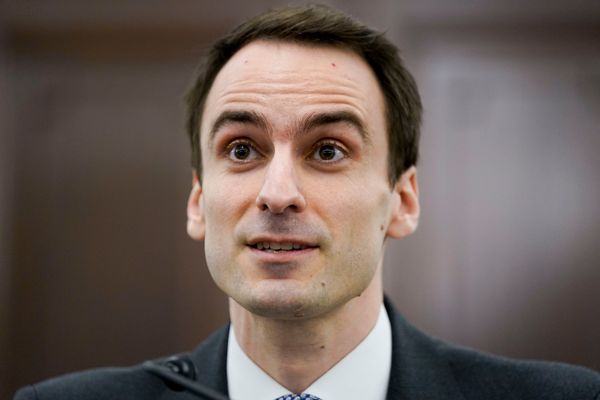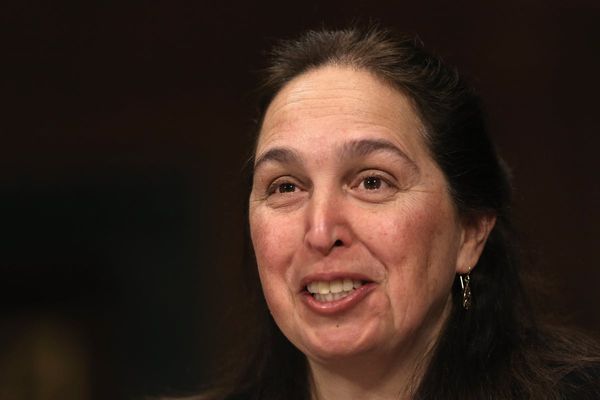
The firebreak between mounting economic threats and a continuation in the global recovery: an imposing concrete and glass structure in the heart of Beijing’s financial district, elephant statues guarding the door, the Chinese flag flying above.
That’s the headquarters of the People’s Bank of China which, in contrast with the U.S. Federal Reserve, has shifted to stimulus mode to shield the world’s biggest growth engine from the Evergrande property slump, virus lockdowns and higher global borrowing costs as the Fed tightens.
Tasked with staving off destabilizing unemployment and a debt implosion, Governor Yi Gang’s PBOC has a newfound autonomy unthinkable a decade ago that may prove crucial in keeping China’s expansion humming above 5% this year.
It’s summed up in a new mantra heard from China’s economic policy makers, roughly translated: “We set our own agenda.”
Decades of stop-start reform have led to freer currency movements and more refined capital controls, meaning that even as the Fed speeds toward a first rate hike since 2018, China’s central bank has autonomy to move in the other direction.
And having avoided the all-out stimulus of Western peers when the Coronavirus first struck in early 2020, the PBOC finds itself with dormant consumer prices and room to “open the monetary policy tool-box.”
For China, that sets the stage for a triple dose of support from increased lending, lower borrowing costs and — potentially — a weaker yuan that would boost exports. The PBOC has already made a down payment on rate cuts and most economists expect more to come.By China’s normal standards, the prize for successful stimulus will be small — more preventing a continued slide in growth than driving a fresh acceleration. And past policy errors — allowing a debt bubble to expand to enormous size — add risk to the outlook and a constraint on the PBOC’s freedom of maneuver.
If Yi and his team can pull it off, though, the boost from PBOC stimulus should offset at least some of the drag on global growth from Fed tightening. International Monetary Fund projections show China is set to contribute more than one-quarter of the total increase in global gross domestic product in the five years through 2026, exceeding the U.S.’s roughly 19% share.
Those with most exposure to China’s economy — commodity exporters like Australia and Asian neighbors like South Korea — will breathe the biggest sigh of relief if efforts at stabilization succeed. Countries with weaker ties to China but more exposure to risks as the Fed tightens — like Mexico and Turkey — have less to gain.Many investors are betting on a rebound in Chinese assets after the MSCI China Index of stocks lagged the S&P 500 by 49 percentage points last year, the biggest gap since 1998. Strategists at Goldman Sachs Group Inc., BlackRock Inc. and HSBC Holdings Plc are among those to have turned bullish on the country's stocks.
Diverging PBOC and Fed policies reflect diverging trajectories for the Chinese and U.S. economies.
In the U.S., the combination of high energy and food prices, supply shortages, and rising rents has pushed the consumer price index to 7% year on year. Markets now view a first Fed rate hike in March as close to a certainty, with the hawkish tone from Chair Jerome Powell at the January FOMC press conference confirming the view. Bloomberg Economics forecasts four more over the course of the year, as well as a speedy start to running assets off the bloated balance sheet.
The PBOC is moving in the opposite direction. Its 10-basis point cut in borrowing costs last week and a pledge to use additional tools was a clear signal that the priority has shifted away from reining in financial risks and toward supporting growth.
The biggest drag comes from the sector that was once China’s most reliable growth driver — real estate. A default by giant developer Evergrande has shaken market confidence, tightening financing conditions. Sales and new construction are now falling at a rapid clip. With property contributing — directly and indirectly — about one in every four yuan of GDP, that’s set to weigh on everything from demand for iron ore to spending on home electronics.
Then there’s the virus. With the Xi’an outbreak triggering more Covid-19 cases than any since the initial wave at the start of 2020, and the arrival of global athletes for the Winter Olympics adding to the petri dish, there’s the risk of further lockdowns. As the experience of the outbreak in summer 2021 demonstrated, even short-lived and targeted measures to control the spread of the virus can take a severe toll on consumer spending.
Pull those pieces together, and China again faces the risk of a significant blow to growth.
A repeat of the massive contraction in output seen at the start of 2020 seems unlikely. Still, the combined impact of national property slump and local lockdowns could be severe. In its recent Financial Stability report, the PBOC envisioned a worst case where growth drops close to 2% — way below the consensus forecast of 5.2% for 2022 and below even the most pessimistic forecast in Bloomberg’s survey of economists.
For the central bank, the best chance of steering a path away from such dire scenarios lies in harvesting the fruits of past reforms.
It’s an idea from the academy that — from former Governor Zhou Xiaochuan to his successor Yi — has held an enduring fascination for top PBOC officials: the impossible trilemma. That’s the theory that an economy can’t control its exchange rate, open to cross-border capital flows and set its own interest rates at the same time — it must pick two of the three.
China’s experience illustrates why.
In 2002, when Zhou took over at the helm of the central bank, China’s yuan was pegged to the dollar. The capital account was closed in theory, but in practice it was easy to dodge controls and move funds in and out of the country.
As a result, the PBOC found itself on the horns of the trilemma, with limited monetary policy independence. Set interest rates too high relative to the Fed, and there would be massive capital inflows. Too low, and capital would flow out.
With the yuan undervalued, interest rates confined within a narrow range, and crude credit quotas the main instrument for managing the ups and downs, the economy ran hot and asset prices soared. The seeds of later problems — like the Evergrande property bubble — were sown.
The move towards more market-driven exchange rates began in 2005 with a one off 2% appreciation against the dollar. The road ahead was far from smooth. Slow progress was a constant source of irritation for the U.S. — which saw an undervalued yuan as an unfair source of competitive advantage for China’s exporters. Some reform steps misfired — as when a mini yuan devaluation in 2015 triggered a global market panic.Even so, in the years that followed -- with stops, starts and major missteps along the way -- the PBOC moved the yuan toward fair value, and all-but eliminated day-to-day intervention in the market. That painstaking process has shifted China to a new regime with a close to market set exchange rate, targeted capital controls, and monetary policy that is now more autonomous from outside influence.
“Because China’s exchange rate policy has become more flexible, maintaining monetary policy independence has become much easier,” says Yu Yongding, a former PBOC adviser and long-time champion of yuan liberalization. His old colleagues agree. In their Monetary Policy report at the end of 2021, the PBOC cities yuan flexibility as one of the big reasons for resilience as the Fed tightens.
A refined set of capital controls also play a role. Even as China allows more two-way movement in its currency and more global investors in to snap up its assets, strict controls remain on individuals’ and companies’ ability to move money abroad. A shift in economic wisdom in the West over the last decade has seen the IMF endorse capital controls it had once called for countries to abolish.
For China, the benefits of reforms can’t arrive soon enough. Lower borrowing costs and abundant liquidity will help prevent contagion from the Evergrande default spreading too far. They should also stoke investment — offsetting at least some of the drag as property construction slumps.
In the past, if lower rates drove yuan weakness that would be a panic signal, requiring the PBOC to wade in to stabilize the market. Now, with acceptance that the yuan is a two-way bet, currency weakness would be an additional benefit by helping drive export earnings.
For the rest of the world, the looming threat of accelerated Fed tightening is a stumbling block on the path to recovery. Never one to miss an opportunity to present China as a force for stability, President Xi Jinping used his speech to the Davos forum this month to warn of “ serious negative spillovers” when the Fed slams on the brakes.
The problem is especially severe for China’s fellow emerging markets, which face the prospect of capital outflows as U.S. rates rise. The prospect of PBOC stimulus stoking Chinese demand promises at least a partial offset, especially for countries like Chile and Brazil that count China among their biggest export customers.
For Asia’s central banks and financial markets, divergence between the Fed and the PBOC will — over time — introduce a new dynamic to navigate. As China’s financial system opens wider, PBOC policy will start to exercise an influence on Asia’s markets that collides with that of the Fed. From Seoul to Jakarta, central bankers and FX traders will have to decide whether it’s U.S. or China policy that is the stronger anchor. Already, some regional currencies are tracking the yuan more than they used to.
Success at stabilizing the economy is far from guaranteed. The PBOC’s progress on reforms came too late to prevent an explosion in debt, which now stands at close to 285% of GDP. The consequences of that are evident in the Evergrande debacle, and the need to deflate the bubble constrains capacity for stimulus.
In a worst-case scenario for the virus — with widespread contagion triggering a new national lockdown — no amount of rate cuts or yuan depreciation would prevent a plummet in output.
Still, at a critical moment, the PBOC’s patiently pursued reforms have bought them at least a little more space for stimulus. Will it be enough? China’s leaders, emerging markets warily eyeing Fed tightening, and investors focused on the risk of debt crisis, hope the answer is yes.
©2022 Bloomberg L.P.







